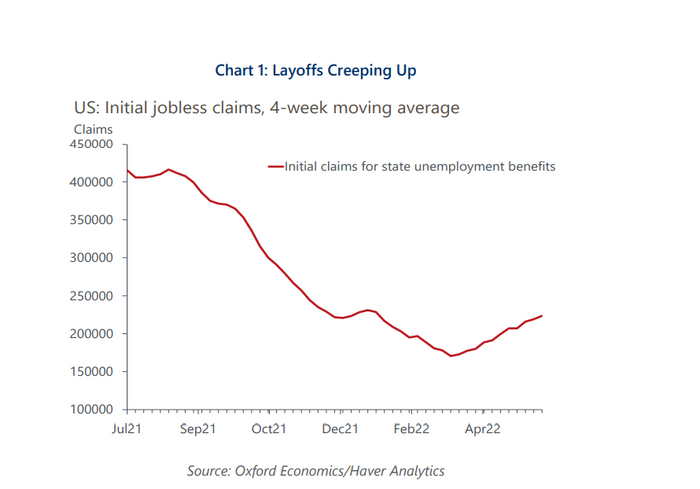It’s easy to want to duck for cover given the carnage seen this year in stocks and bonds, particularly with the Federal Reserve vowing to wage an unconditional battle against high inflation.
While inflation running at a 40-year high still sits near the top of the list of worries for many investors, another potential bugaboo for markets has begun to lurk, in the form of slower corporate earnings growth — and potentially in the broader U.S. economy.
“I would say there’s definitely a concern that earnings expectations are dropping again. Softening, but not falling off a cliff,” said Jake Remley, senior portfolio manager at Income Research + Management, by phone.
Ahead of fresh corporate results beginning in mid-July, analysts pegged the S&P 500 index’s SPX, +3.06% estimated earnings growth rate for the second quarter at 4.3%, according to a Friday report from FactSet, a level that would mark its lowest yearly growth rate since the fourth-quarter of 2020.
“You could argue that bad news is going to take some pressure off the Fed,” Remley said, speaking of the Federal Reserve’s plans to dramatically tighten financial conditions this summer, in a bid to cool soaring inflation.
“They don’t want to break the consumer, or the corporate bond market, or bank balance sheets,” he said. “But it’s going to take more than what they’ve done, from our perspective,” to avoid high costs of living from becoming entrenched.
“The faster they do it, the better.”
Recession or inflation?
It’s a delicate dance. The Fed wants to cool demand for goods and services, through starkly higher interest rates, but without going too far, throwing workers out of jobs by triggering an economic recession.
San Francisco Federal Reserve President Mary Daly on Friday added her support for another big interest-rate hike in July to target high inflation, without derailing the economy.
“The biggest fear isn’t one or the other — it’s both,” said Mark Heppenstall, chief investment officer at Penn Mutual Asset Management, about whether a growth scare or inflation matters the most.
The U.S. economy shrank 1.4% on an annualized basis in the first quarter. With higher interest rates and tighter financial conditions, the economy could be on the path of a technical recession, he said, by phone.
“It’s definitely feeling like a period of stagflation, which is why we are seeing so much volatility in asset prices and in interest rates.”
Stocks rallied this week, with the S&P 500 SPX, +3.06% ending 3.1% higher Friday, to book its best day in more than two years. But the broad-market gauge still was down 17.9% for the year, in a bear market, with the Nasdaq Composite Index COMP, +3.34% off 25.8% so far in 2022, according to FactSet.
The blue-chip Dow Jones Industrial Average DJIA, +2.68% surged 5.4% for the week, but was still down 13.3% for the year so far.
Tracking layoffs
A key component of ’70s-style stagflation was the mix of both high inflation and a weak labor market. By comparison, the current employment picture still looks pretty robust.
That could change quickly, however, if more companies start reporting disappointing corporate earnings, not only as a strong dollar crimps international sales, but more broadly from the ripple effects of inflation at 8.6%, its highest in 40 years.
“The inflation rhetoric is cooling, while the recession narrative is gaining headlines,” said Bob Schwartz, senior economist at Oxford Economics, in a Friday note. “That pivot in sentiment is coursing through the financial markets.”
He also pointed to retreating bond yields as a potential harbinger of an economic slowdown. The benchmark 10-year Treasury yield TMUBMUSD10Y, 3.135% was at 3.125% Friday, well off the recent peak of 3.482% hit on June 14, according to Dow Jones Market Data.
“Layoffs are creeping up and job offers are being rescinded,” Schwartz said.

Layoffs edge higher
Oxford Economics
While “job searchers have more than enough positions to choose from,” Schwartz said, he also echoed some concerns voiced this week by Sen. Elizabeth Warren during Fed Chair Powell’s two-day testimony on Capitol Hill. They both stressed that the labor market could weaken as a result of the central bank’s tactics to fight inflation.
Namely that the “strong bargaining position that workers have enjoyed over the past two years may be eroding.”
Among the key economic data on tap: Monday will bring pending home sales for May, following by the April reading of the S&P Case-Shiller U.S. home price index on Tuesday. Wednesday brings updated U.S. GDP for the first quarter. Thursday has more inflation data for May.






